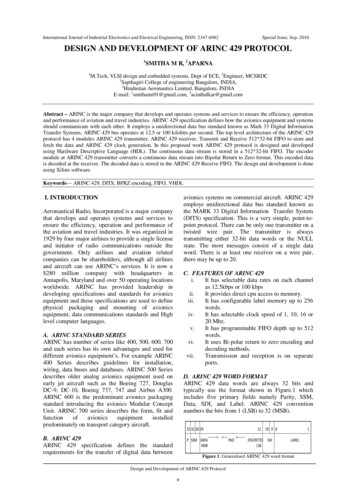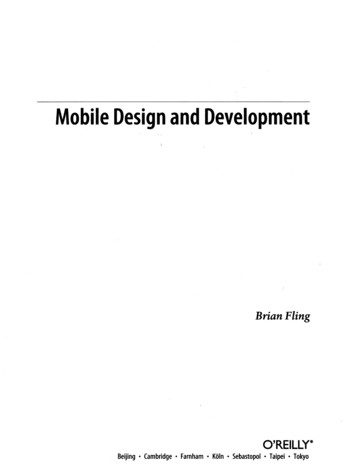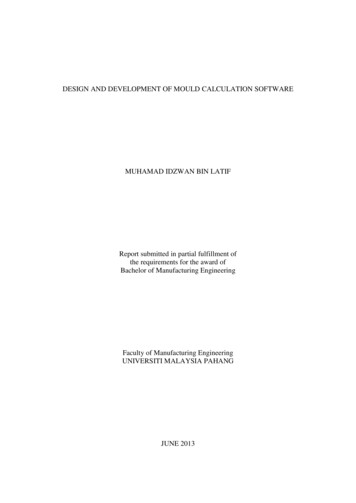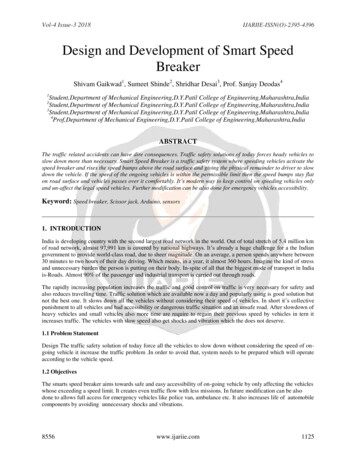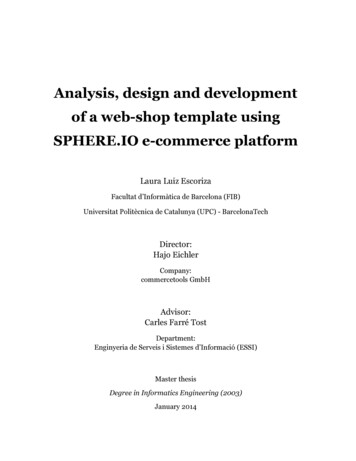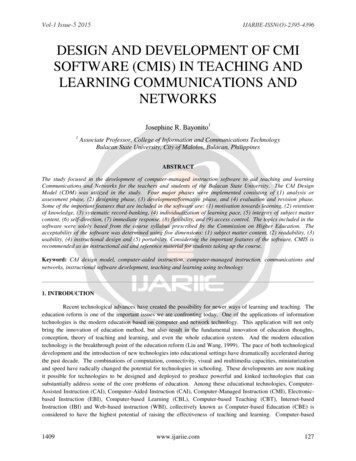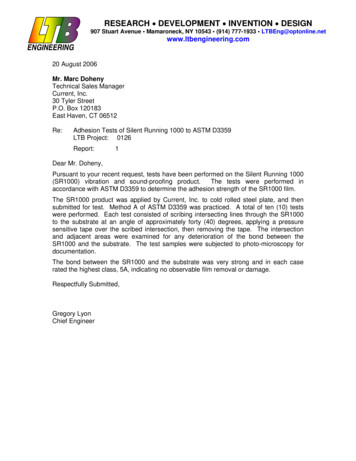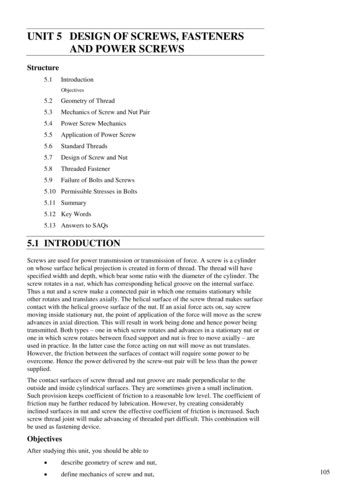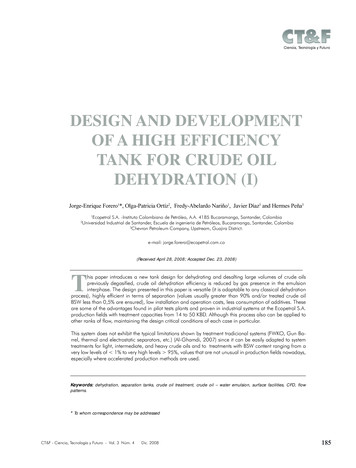
Transcription
DESIGN AND DEVELOPMENT OF A HIGH EFFICIENCY TANK FOR CRUDE OIL DEHYDRATION (I)Ciencia, Tecnología y FuturoDESIGN AND DEVELOPMENTOF A HIGH EFFICIENCYTANK FOR CRUDE OILDEHYDRATION (I)Jorge-Enrique Forero1*, Olga-Patricia Ortíz2, Fredy-Abelardo Nariño1, Javier Díaz3 and Hermes Peña321Ecopetrol S.A. -Instituto Colombiano de Petróleo, A.A. 4185 Bucaramanga, Santander, ColombiaUniversidad Industrial de Santander, Escuela de ingeniería de Petróleos, Bucaramanga, Santander, Colombia3Chevron Petroleum Company, Upstream, Guajira District.e-mail: jorge.forero@ecopetrol.com.co(Received April 28, 2008; Accepted Dec. 23, 2008)his paper introduces a new tank design for dehydrating and desalting large volumes of crude oilspreviously degasified, crude oil dehydration efficiency is reduced by gas presence in the emulsioninterphase. The design presented in this paper is versatile (it is adaptable to any classical dehydrationprocess), highly efficient in terms of separation (values usually greater than 90% and/or treated crude oilBSW less than 0,5% are ensured), low installation and operation costs, less consumption of additives. Theseare some of the advantages found in pilot tests plants and proven in industrial systems at the Ecopetrol S.A.production fields with treatment capacities from 14 to 50 KBD. Although this process also can be applied toother ranks of flow, maintaining the design critical conditions of each case in particular.TThis system does not exhibit the typical limitations shown by treatment tradicional systems (FWKO, Gun Barrel, thermal and electrostatic separators, etc.) (Al-Ghamdi, 2007) since it can be easily adapted to systemtreatments for light, intermediate, and heavy crude oils and to treatments with BSW content ranging from avery low levels of 1% to very high levels 95%, values that are not unusual in production fields nowadays,especially where accelerated production methods are used.Keywords: dehydration, separation tanks, crude oil treatment, crude oil – water emulsion, surface facilities, CFD, flowpatterns.* To whom correspondence may be addressedCT&F - Ciencia, Tecnología y Futuro - Vol. 3 Núm. 4Dic. 2008185
JORGE-ENRIQUE FORERO et al.n este documento se presenta el diseño de un nuevo tanque para deshidratación y desalado degrandes volúmenes de crudo previamente desgasificado, la eficiencia de deshidratación de crudo esreducida por la presencia de gas en la interfase de la emulsión. El diseño presentado es muy versatil(adaptable a cualquier proceso clásico de deshidratación), altamente eficiente en términos de separación(valores de eficiencia mayores a 90% y/o BSW en el crudo menor a 0,5% son asegurados), bajos costos deoperación e instalación, menor consumo de aditivos. Estas son algunas de las ventajas encontradas en laspruebas de planta piloto y posteriormente probadas en sistemas industriales en campos de producción deEcopetrol S.A. cuyas capacidades de tratamiento están entre 14 y 50 KBD, aunque este proceso tambiénpuede ser aplicado a otros rangos de flujo, manteniendo las condiciones críticas de diseño para cada casoen particular.EEste sistema no tiene las limitaciones típicas mostradas por los sistemas tradicionales de deshidratación(FWKO, Gun Barrel, separadores térmicos y electrostáticos) (Al-Ghamdi, 2007) debido especialmente a quees fácilmente adaptable para el tratamiento de crudos livianos, medios y pesados con contenido de BSWdesde niveles muy bajos 1% a niveles muy altos 95%, los cuales son usuales actualmente en los camposde producción, especialmente donde se usan métodos de producción acelerados.Palabras Clave: deshidratación, tanques separación, tratamiento de crudo,emulsión crudo-agua, facilidades de superficie, CFD, patrones de flujo.186CT&F - Ciencia, Tecnología y Futuro - Vol. 3 Núm. 4Dic. 2008
DESIGN AND DEVELOPMENT OF A HIGH EFFICIENCY TANK FOR CRUDE OIL DEHYDRATION (I)INTRODUCTIONOne of the main characteristics of this new separation or dehydration tank design for crude oils inproduction fields is a controlled and appropriate flowpattern to ensure high separation indexes of suspendedwater particles thus ensuring more appropriate conditions to maximize flocculation and agglomerationphenomena. These are the most important separationprocesses for this kind of emulsions (Finborud, Faucher, & Sellman,1999; Al-Ghamdi & Kokal, 2003).One of the best ways to increase the occurrenceof the flocculation and agglomeration phenomena inthese emulsions is by the formation of a large crudewash water interphase minimizing turbulence zones,that affects negatively the separation of smaller waterparticles, as well as acting on the zones of nil or lowflow that limit drastically the treatment capacity ofinstalled equipment (Zemel & Bowman, 1978; Lee &Frankiewicz, 2005).The study of these flow patterns had already beenconducted in previous works by Ecopetrol at Instituto Colombiano del Petróleo (ICP) (Forero, Sierra,& Blandon, 1999). These works were related to theoptimization of treatment systems of waste waters byinduced flotation. Therefore, some tank designs anddevelopments proposed in this paper have already beenevaluated from the dynamic fluid standpoint and are derived from the designs developed. In former evaluations,these designs demonstrated to be the flow hydraulicmodels required for performance at the ideal conditionsto break crude oil-water emulsions. In a simple form,these can be described as flow systems with a tendencyto piston flow (Zemel & Bowman, 1978; Frankiewicz& Lee, 2001)Evaluations were also conducted to determine theinfluence of other critical variables such as time ofresidence, fluid density difference, flow velocity, viscosity, injection system geometry, and a collector systemgeometry. In general terms, these evaluations involved thestudy of the necessary internal geometry to keep velocityconditions and flow parameters at the optimum conditions required for non-gas phase separation in productionfluids (Forero, Sierra, & Hernández, 2000).CT&F - Ciencia, Tecnología y Futuro - Vol. 3 Núm. 4Dic. 2008This paper reviews and evaluates the main variablesaffecting the emulsions formed by crude oil and water,defining their influence in crude oil dehydration anddesalting systems in production fields. Different alternatives to make separation processes more efficient areproposed to ensure good commercial conditions and disposition of production crude oil and water, respectively(Kokal, 2000; Marfisi & Salager, 2004).The system presented offers great advantages forproduction field operation, such as the assuranceof high fluid treatment capacities in low-volumetanks, with lower operation costs compared to conventional systems since, in general terms, specializedseparation processes such as thermoelectrostatic systems,high temperature, cyclons, expensive chemical additives,re-processing are not required.By contrast to conventional processes, its efficiencyis not limited by ordinary operational changes in production fields such as, among other, a sudden variationof flow process conditions, temperature, or viscositypresent in operations at multi-well fields.The advantages of this tank result in considerablesavings (usually greater than 50%) in capital investment,operation costs and represent a solution for crude oilquality problems in those regions where conventionalprocesses are limited by conditions of time, area, investment, and fluid characteristics.THEORETICAL FRAMEWORKThe theoretical framework of this document focuseson the characteristics, occurrence, formation, stability,management and breaking of water-crude oil emulsionsin production fields.Crude oil-water separation is one of the main operations required in the petroleum industry to yield productsaccording to specifications. This process is requiredfor posterior transportation and storage activities sincecrude oil must have minimum content of water, saltsand sediments (BSW). On the other hand, the production water must also conform to the specifications oflow content of organic substances, either dissolved or187
JORGE-ENRIQUE FORERO et al.suspended. This is important because this water is usedas raw material in water injection or re-injection systemsor disposed to the environment where it wouldn’t affectthe natural conditions.This separation process is mainly controlled by adynamic fluid equilibrium of emulsification and flocculation, available at all the petroleum production line,from the reservoir to the consumption of each derivativeresulting from crude oil industrialization (Al-Ghamdi &Kokal, 2003; Noik, Trapy, & Mouret, 2002).Emulsification predominates when two fluids aresubmitted to high velocities and shear stress (highdissipation of energy) which are mainly found inchokes, flow and control valves, surface and wellbottoms pumps and in the porous body of the formation (Van der Zande, Van Heuven, Muntinga, & Vanden Broek, 1999). Regarding flocculation, the processis divided in two fundamental sub-processes: particlegrowth by coalescence and separation by sedimentation or floating (creaming) of the disperse phase, eachof them developed under specific flow conditions. Forinstance, coalescence has a special effect in transportation through pipelines, entry to tanks, and separation equipment (Hafskjold, Celius, & Aamo, 1999;Arnold & Koszela, 1999), and in dissipation zonesof moderate energy. Separation by sedimentation orfloatation is given especially in low-velocity regionsand shear stress (low dissipation of energy) such asseparation tanks, pools etc. Therefore, the efficiencyof a separation system such as the tanks proposed inthis paper depends not only on dynamic flow conditionsof the separation recipient but also on the history ofthe fluid being treated, especially regarding the energydissipation conditions of former processes. Chemicalchanges to which the fluid has been submitted also playan important role. This refers to mixtures with otherfluids, general additives used in its production, and thematuration age of the crude oil under treatment (Auflem,2002; Menga, Jaworski & White 2005; Alayon, 2004;Aske, 2002).Studies have been conducted by Instituto Colombiano del Petróleo (ICP) - Ecopetrol S.A. (Forero,Sierra, & Hernández, 2000) and other research centerson the hydraulic characteristics of separators of crude188oil - water emulsions and the way these flow patternsare correlated to separator effectiveness. It has beenfound that flow patters usually produced in separatorsof crude-water systems at production fields are verydispersed regarding the time of residence. This meansthat the use of the total tank capacity is limited and flowshort circuits appear, thus generating zones of very lowor nil flow. Conversely, very high flow zones are alsogenerated producing high cutting stress values at themain characteristic of flow conditions, thus generatinglow times of treatment and forces that even can generateappropriate conditions for emulsion formation. This isan undesirable situation (Sjöblom, 2002).One of the conclusions resulting from these experiencesis that one of the most appropriate patterns to be used inseparators of treated emulsions is generated in gasfloatation systems that reproduce more accurately theseries tank model. This is ideal for the separation processes proposed in this article. (Zemel & Bowman,1978;Forero, 1999)The tanks with more limited characteristicsregarding their flow conditions are the separationtanks (Gun Barrel), wash tanks or skim tanks, that lackconditioned internal arrangements to maintain fluidflow at the conditions required for breaking crude oil– water emulsions. Most of the time, while attemptingthe installation of distribution systems and baffles forthe management of required flow conditions, flowpatterns are generated. In most cases, these patternsare even worse in tanks without internal structures.Some typical cases of this situation are those separatorsthat utilize distributors, baffles, or internal structures thatare very dependent on fluid properties. These separatorswork efficiently under ideal conditions, being severelylimited in their operation when slight changes to theseconditions occur, such as sudden changes in fluid flow orcomposition, formation of solid deposits, gas dragginginto the liquids, etc. (Van Den Boek et al., 1999). Theprocess proposed in this paper; has demonstrated to bevery stable with regard to the appearance of the changesthat limited former designs of internal structures. Its design is not only defined in function of the geometry of theinternal structure distribution, but also design conditionswere considered such as phase contact velocities, washarea density (vol. oil/vol. wash water), flow regime inpipelines of internal structures, wash time, etc.CT&F - Ciencia, Tecnología y Futuro - Vol. 3 Núm. 4Dic. 2008
DESIGN AND DEVELOPMENT OF A HIGH EFFICIENCY TANK FOR CRUDE OIL DEHYDRATION (I)Crude oil water Systems in Production FieldsAs it has been mentioned, crude oil is usually produced with water in a conjoint manner. This water canbe present in production fluids in several forms such asfree water, emulsified water, and dissolved water. Thetotal proportion of water in production processes variesin broad ranges, as it is stated in Table 1.Table 1. Typical content of water in petroleum productionFree waterEmulsifiedwaterDisolved waterMax80%20% 0,1%min10% 0,1% 0,01%The separation of production water from hydrocarbon compounds, its treatment and disposition inan appropriate manner involve the generation of morecosts during crude oil production. The crude oil produced must conform to sale and processing conditionsthat determine the minimum amount of sediments, saltand water (BSW).The incremental production costs of crude oils dueto water formation dragged to the process and otherfluids can be so high that can determine the economicfeasibility of production of a specific field. These costsare mainly represented by production costs associatedto energy, transportati
(FWKO, Gun Barrel, separadores térmicos y electrostáticos) (Al-Ghamdi, 2007) debido especialmente a que es fácilmente adaptable para el tratamiento de crudos livianos, medios y pesados con contenido de BSW desde niveles muy bajos 1% a niveles muy altos 95%, los cuales son usuales actualmente en los campos de producción, especialmente donde se usan métodos de producción acelerados .

